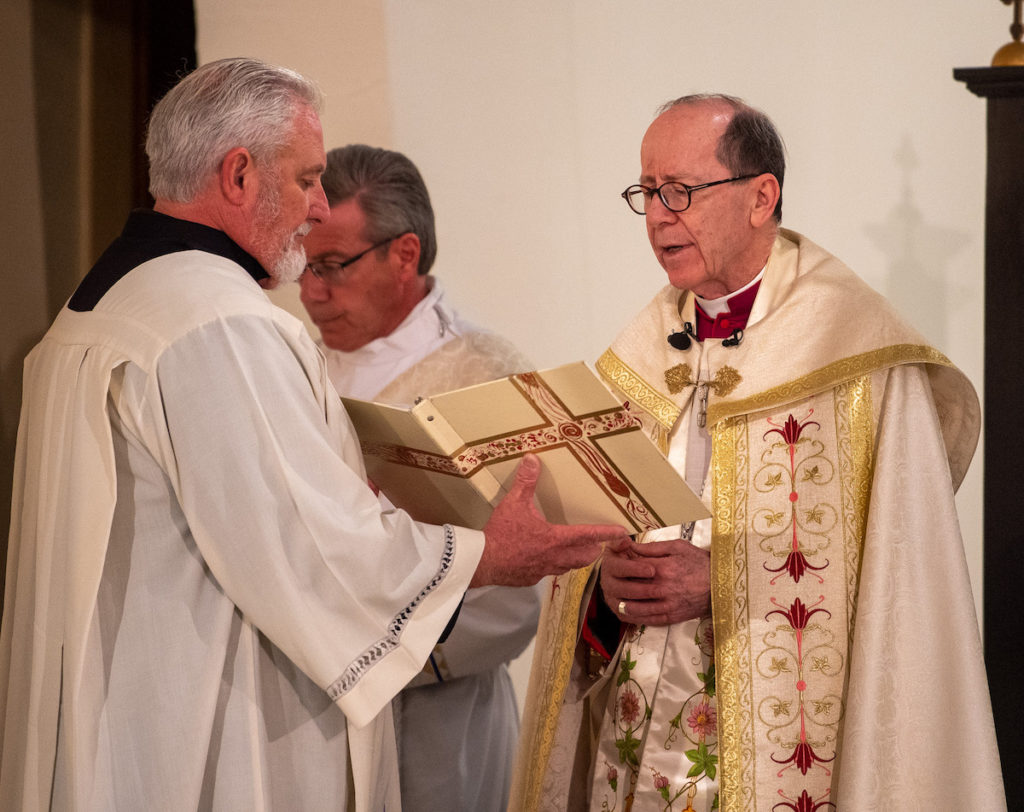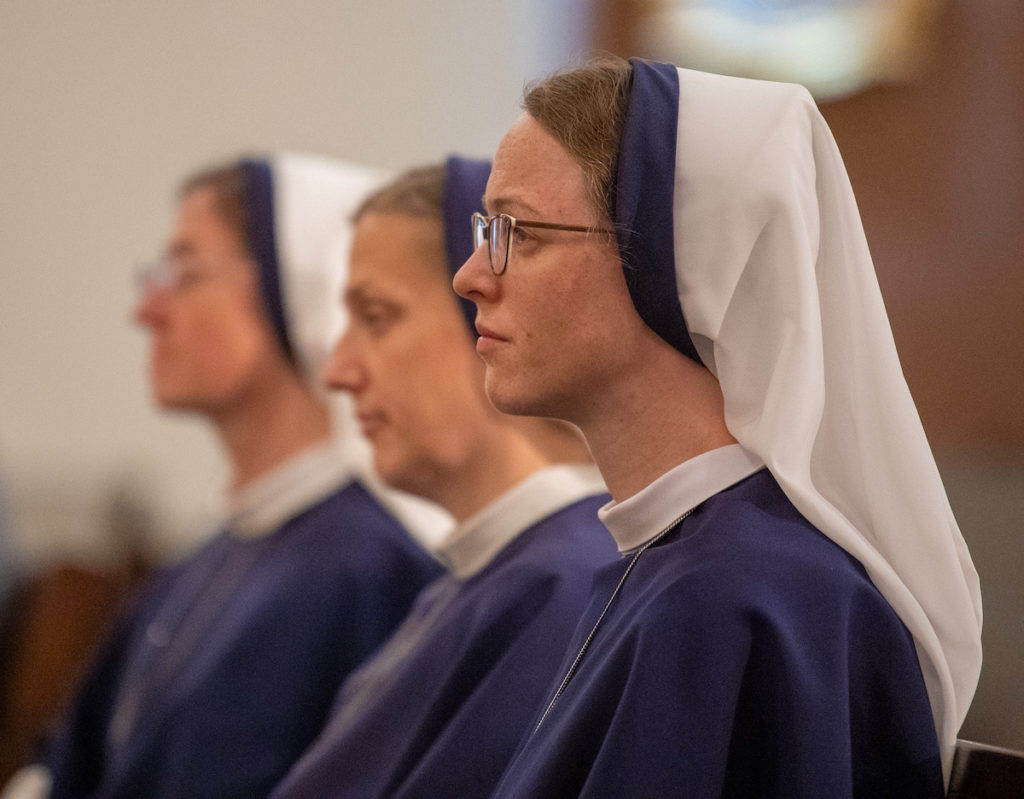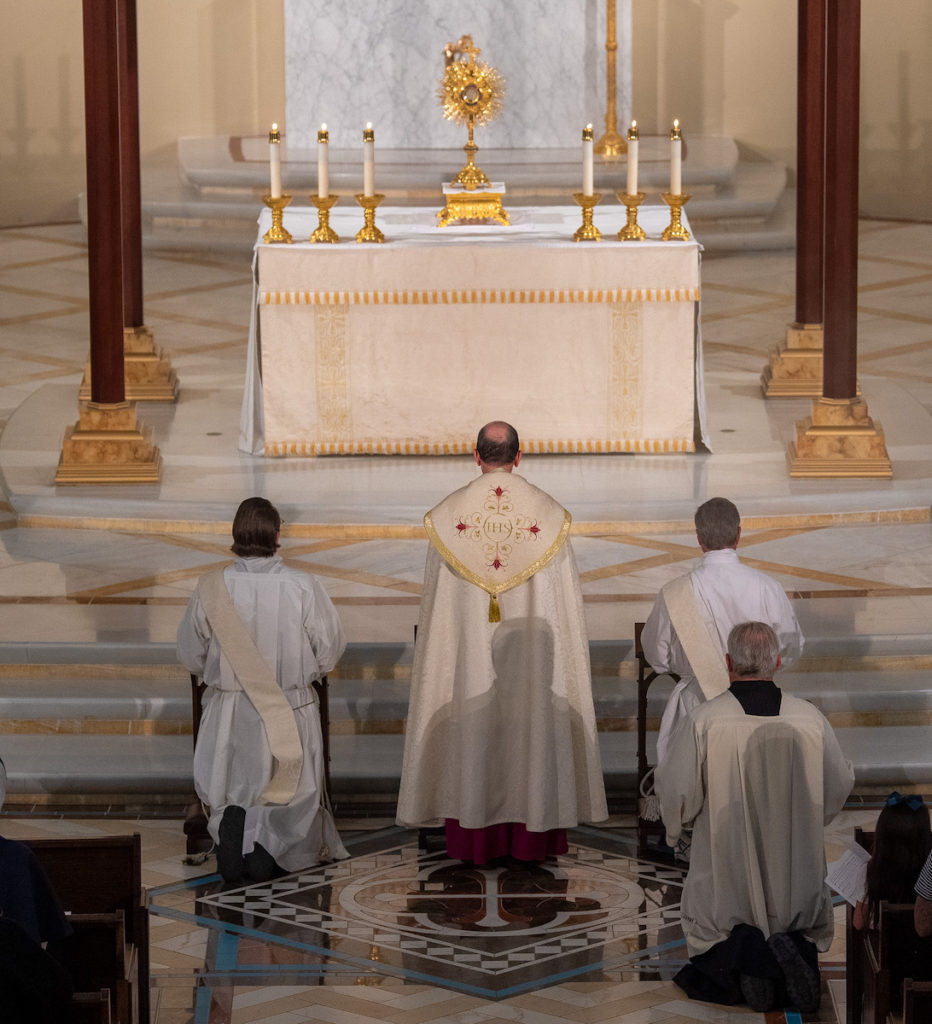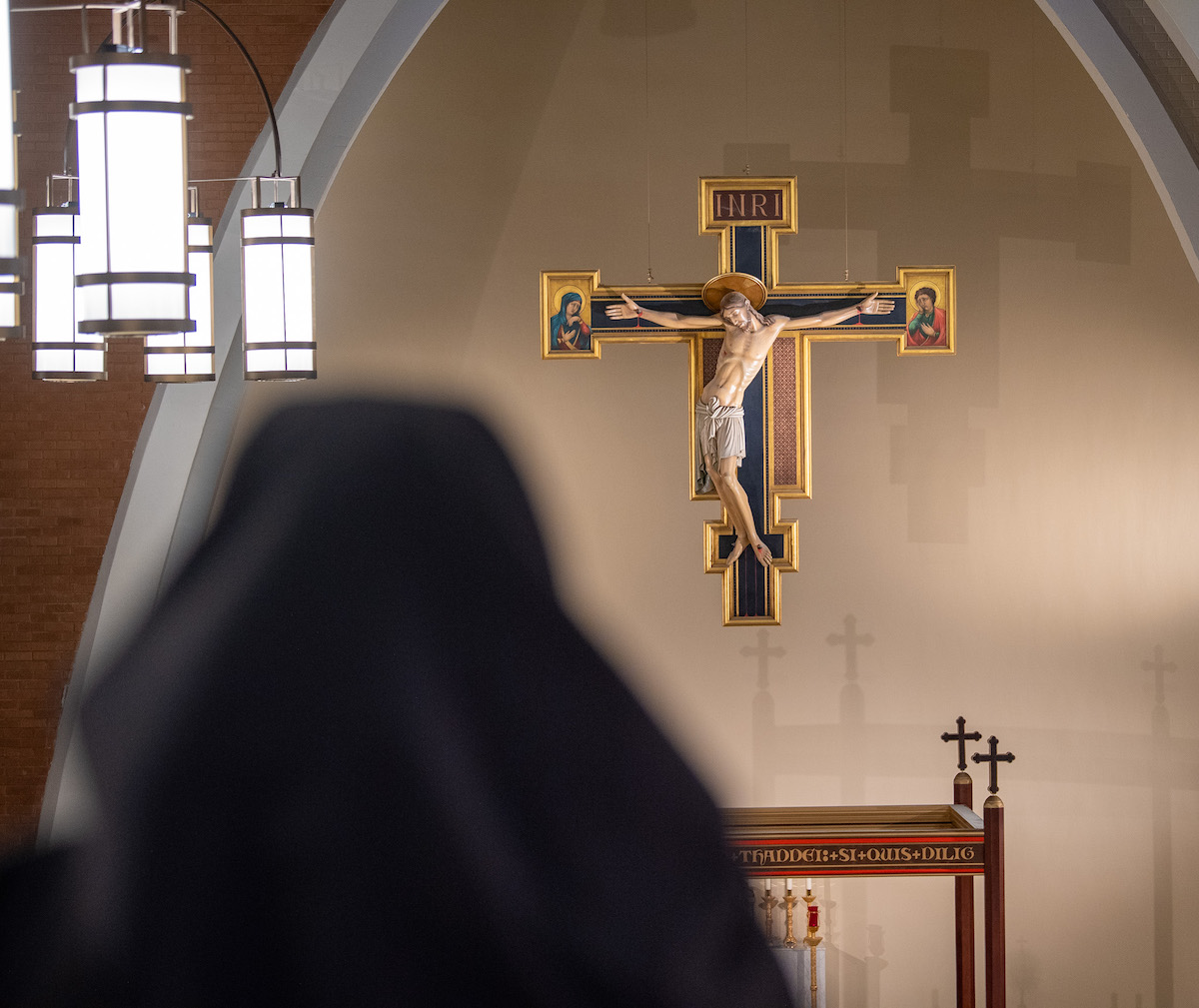
By Jeff Grant, The Catholic Sun
PHOENIX – On May 10, as the state of Arizona prepared to carry out its first death sentence in nearly 9 years and with a second execution expected a month later, Bishop Thomas J. Olmsted of the Diocese of Phoenix reaffirmed the Catholic Church’s opposition to capital punishment, leading a prayer vigil at Ss. Simon & Jude Cathedral for an end to the practice.
“Jesus did not desire the death of a sinner, but that he turn back to the Father and be forgiven,” Bishop Olmsted said during his homily.
“We who oppose the death penalty are convinced that even a terrible crime does not remove the human dignity of the criminal. Everyone is created in the image and likeness of God, and for every human person – even the greatest sinner – Jesus suffered and died on the Cross to redeem us from our sins,” he said.
The homily was part of an hourlong prayer service that began with the exposition of the Blessed Sacrament and several minutes of silent adoration. The vigil also included praying the Litany of Trust by the Sisters of Life and the Chaplet of Divine Mercy.

The evening’s liturgy of the word spoke directly to the issue of murder, divine punishment, and protection of the killer, as well as a dying criminal’s confession and redemption through Christ.
The first reading, from the Old Testament Book of Genesis, recounted Cain’s killing of his brother Abel – the first murder – and God’s sentence of Cain.
“Now you are banned from the ground that opened its mouth to receive your brother’s blood from your hand. If you till the ground, it shall no longer give you its produce. You shall become a constant wanderer on the earth,” the Lord tells Cain.
The sentence triggers a plea from Cain, who fears wandering the earth will surely lead to his own death at the hands of others.
But verse 15 provides this response from God: “Not so! If anyone kills Cain, Cain shall be avenged seven times. So, the Lord put a mark on Cain, so that no one would kill him at sight.”
The Gospel reading, Luke 23:39-43, told the account of the repentant criminal sentenced to die next to Jesus, who recognized Christ’s innocence and divine authority and sought forgiveness from the Savior.
“Amen, I say to you, today you will be with me in Paradise,” Jesus responds, granting absolute forgiveness in one of his last acts as he hung from the Cross, dying.
The evening’s statements from Bishop Olmsted and his colleagues reflected the themes of mercy and human dignity, even for killers.
Read the 2022 ACC statement on the resumption of the death penalty in Arizona.
The evening began with Kevin J. Starrs of the Diocese’s Office of Prison Ministry reading a statement on capital punishment released May 2 by the bishops of the Arizona Catholic Conference (ACC), the public policy agency for the Diocese of Gallup, the Diocese of Phoenix, the Diocese of Tucson, and the Holy Protection of Mary Byzantine Catholic Eparchy of Phoenix, which serves Byzantine Catholics in the Western United States.
The statement was also a reaffirmation of the Conference’s 2007 declaration, reaffirmed in 2010 and 2011. It read in part, “there is no doubt that the state has an obligation to promote the common good by punishing criminals and preventing the recurrence of crime,” and “brutal crimes such as murder are certainly deserving of a punishment proportionate to the gravity of their offense.” but “the death penalty… disregards the dignity of human life and the inherent dignity of each person.”
Read the 2007 ACC statement in full.
‘FLAWED’ LAW
Further, the bishops have cited “flaws” in the law as well as its application.
The 2007 statement pointed to more than 100 cases nationwide over a 20-year period, including some in Arizona, in which it was learned prior to execution that a criminal sentenced to die had been wrongly convicted. Those discoveries came either through DNA or other evidence proving the individual’s innocence. By 2022, the bishops pointed out the number of exonerations had grown to 180, including 10 Arizona cases.
The bishops named other problems as well.
For example, the law is not equally applied, they said.
“…across the nation, including in Arizona, the use of the death penalty is troublesome because it is often influenced by factors such as geography, and is disproportionately imposed on people of color and of limited economic means.”
The bishops, echoing words of both St. John Paul II and Pope Francis, have said the development of a modern penal and prison system in many countries means capital punishment is no longer needed to protect society – one of its original intents centuries ago.
Today’s prisons hold convicts in a way those of the past could not be counted on, they asserted.
“Modern society has the means of protecting itself, without definitively denying criminals the chance to reform,” Bishop Olmsted said, quoting from John Paul II’s homily during his visit to St. Louis, Mo.’s Trans World Dome Jan. 27, 1999. Those words recalled the pontiff’s own in his 1995 Encyclical, Evangelium Vitae, and were later echoed by Francis in his 2020 Encyclical, Fratelli Tutti, in which Francis said, “it is impossible to imagine that states today have no other means than capital punishment to protect the lives of other people from the unjust aggressor.”

NO LONGER IN GOD’S IMAGE
The dignity of each individual inherent as a creation of God remained the heart of the message.
“The Church has the deepest compassion for those victimized by brutal crimes as well as their families,” the bishop told the vigil congregation at Ss. Simon & Jude. “Accordingly, we need always to pray for healing for all those affected by these crimes. (but) “We believe that all human life, each human person, from conception to death, is sacred.”
“Is a convicted murderer no longer made in the image of God?” the bishop asked.
“Certainly, he ought to be punished. Certainly, society must be protected against someone proven to be murderous. But even a murderer is not outside the infinite mercy of God.”
“The possibility of true repentance and salvation remains for every person as long as he is still alive.”
The bishop also used the example of Mary.
Noting how she heard the prayerful appeal of one of the dying criminals and her beloved son respond with the promise of eternal life, Bishop Olmsted said, “She pondered it in her heart, a heart that was pierced with the sorrow of watching her innocent son executed. Surely, Mary, the mother of Jesus, is here with us this evening, and she is close to the victims and the families impacted by horrendous crimes such as the one of which Clarence Dixon was convicted.”
“At the same time, Mary remembers the sincere repentance of the good thief and the abundant mercy with which Jesus looked upon him,” he said.
Finally, the bishop said the death penalty “contributes to a culture of death…” “using killing to solve a problem.”
He closed his homily with prayers for Dixon, who was executed the next morning, that ”he may die with a contrite and repentant heart.”
Witnesses to Dixon’s execution said there was no expression of repentance, no words of remorse.
Dixon, 66, was convicted in 2008 for the 1978 murder of Deana Bowdoin, 21, a senior at Arizona State University in Tempe. Bowdoin was found dead inside her apartment with a belt around her neck. The case went unsolved for years until DNA evidence from the murder scene was matched to Dixon in 2001. At the time, Dixon was serving time for a 1986 sexual assault.
Dixon was the first of two executions scheduled about a month apart.
Frank Atwood, 65, is slated to be put to death June 8 for the murder of 8-year-old Vicki Lynn Hoskinson in 1984. Authorities say the girl was killed by Atwood after he kidnapped her.
Her body was found in the desert in southern Arizona.
No other execution dates have been announced.
There are currently 112 inmates on Arizona’s death row, including three women, according to the Arizona Dept. of Corrections Rehabilitation and Re-entry.
A NATION DIVIDED
The vigil and Dixon’s execution came as U.S. Catholics and the general public remain divided over capital punishment.
The Washington, D.C.-based Pew Research Center, a nonpartisan fact tank, found 60 percent of over 5,100 American adults responding to a 2021 survey favored capital punishment.
Among Catholics – 60 percent said that in cases of crimes such as murder the death penalty is morally justified. Fifty-six percent of White Catholics and 61 percent of Hispanic Catholics supported the use of the death penalty over all.
The same survey found 75 percent of White evangelicals, 50 percent of Black protestants, and 35 percent of atheists support the use of the death penalty. Still, large majorities in every religious group acknowledge some risk that an innocent person will be put to death.
A total of 5,970 persons, with a proportionately larger amount of Asian, Black and Hispanics polled, were surveyed. A total of 5,109 responded, for an 86 percent response rate.
Get the full survey details, including Pew’s methodology.
A similar Pew survey in 2018 found 53 percent of Catholics supporting the death penalty and 42 percent opposed. Five percent were undecided. Those survey results reversed a gradual trend since 1998 of declining support for the death penalty, according to Pew.
Mike Phelan, director, of the Diocese of Phoenix’s Office of Marriage and Respect Life, said that the issue is a difficult one for some Catholics as well as those outside the faith.
“I do think people struggle with this issue, particularly if they have been impacted in their family or know someone who has been impacted in their family by a heinous crime because we do have this sense of justice, and how do you balance the scales of justice when there has been a horrible, intentional evil (committed).”
“I think there is some difficulty about this among Catholics because we don’t want to violate justice when we argue for mercy,” he said.
THE DEATH PENALTY IN ARIZONA
The number of states allowing the death penalty versus those that don’t reflect the country’s division over the issue. Currently, 24 states allow capital punishment; 23 do not.
Three of the states where the death penalty is in in place – California, Oregon and Pennsylvania – each have moratoriums imposed by the governor. The states that allow for the death penalty are in the Southwest, lower Midwest, and South. Those without it are mostly in the upper Midwest and Northeast, though the group includes New Mexico and Colorado.
Governors imposing the moratorium cited a “flawed system.”
In his March 13, 2019, action, Calif. Gov. Gavin Newsom stated of the death penalty: “It has discriminated against defendants who are mentally ill, Black and Brown, or can’t afford expensive legal representation. It has provided no public safety benefit or value as a deterrent. It has wasted billions of taxpayer dollars. But most of all, the death penalty is absolute. It’s irreversible and irreparable in the event of human error.”
Pennsylvania Gov. Tom Wolf, on Feb. 19, 2015, stated, “This moratorium is in no way an expression of sympathy for the guilty on death row, all of whom have been convicted of committing heinous crimes. This decision is based on a flawed system that has been proven to be an endless cycle of court proceedings as well as ineffective, unjust, and expensive. Since the reinstatement of the death penalty, 150 people have been exonerated from death row nationwide, including six men in Pennsylvania.”
Learn more from the Death Penalty Information Center
A number of states have abolished the death penalty in the past 20 years.
According to the National Conference of State Legislatures (NCSL), a bipartisan organization founded in 1975 in part to promote cooperation among legislatures and represent their causes before the federal government, New Hampshire (2019), Colorado (2020), and Virginia (2021) became the latest to abolish capital punishment.
Arizona stopped carrying out death sentences in 2014, after the execution of Joseph Wood, who was put to death using a two-drug injection mixture that took over 2 hours. In 2017, the state’s plan to improve the process was accepted by a federal judge, clearing the way for executions to resume.
And U.S. death row inmates are getting more time to ponder their eternal destiny. Since 1937, the average Arizona death row inmate has spent 12 years there from sentence to execution, according to the Arizona Dept. of Corrections Rehabilitation & Re-entry. That figure is just under 17 and a half years for the 34 inmates put to death since 1992, the department reports.
Nationwide, the figure is 18.7 years, according to the U.S. Dept. of Justice’s Bureau of Justice Statistics June 2021 report on Capital Punishment for 2019. That year, seven of the 29 states with a death penalty conducted an execution. Inmates executed in 2019 had been on death row an average of 22 years.
A FINAL INTERVENTION
According to the Death Penalty Information Center (DPIC), a national nonprofit organization serving the media and the public with analysis and information on issues concerning capital punishment, U.S. death-row inmates typically spend more than a decade awaiting execution or court rulings overturning their sentences. Half of all death-row exonerations have taken more than a decade, and the length of time between conviction and exoneration has continued to grow. More than half of the exonerations since 2013 have taken 25 years or more.
The longest-serving inmate on Arizona’s Death Row, Joe C. Smith, was sentenced Nov. 1, 1979. Eldon M. Schurz, the second-longest serving inmate, has been there since shortly after sentencing Oct. 20, 1981, and Eric. O’ Mann, the third-longest occupant, has been there since shortly after May 31, 1982, according to the state Dept. of Corrections.
DPIC states the typical U.S. death row inmate spends up to 23 hours a day alone in his or her cell, sharply restricted in terms of visitation and exercise, and excluded from education and employment programs. Arizona’s department reports its inmates receive limited access to general reading materials, including permission to borrow two books every 2 weeks.
They are allowed non-contact visits during which the visitor and inmate are separated by a glass partition and speak to one another by phone. They have full access to the courts and unlimited access to legal research materials.
Arizona’s governor, who is Catholic, cannot intervene on his own to stop an execution.
While the Arizona Constitution gives the governor the power of clemency, under this law that power only may be exercised upon recommendation from a 5-member Board of Executive Clemency.
The Clemency Board declined to recommend reducing or changing Dixon’s sentence on April 29. This is the only case the board has reviewed since Gov. Doug Ducey took office in 2015.
According to the Death Penalty Information Center, Arizona has never granted clemency to a death row inmate.
Learn more about Arizona’s provisions on clemency and the board.







